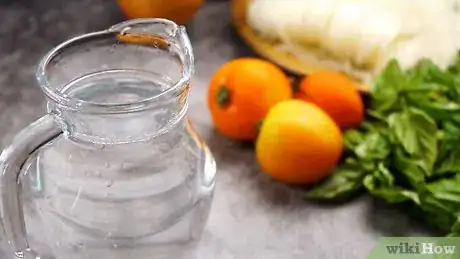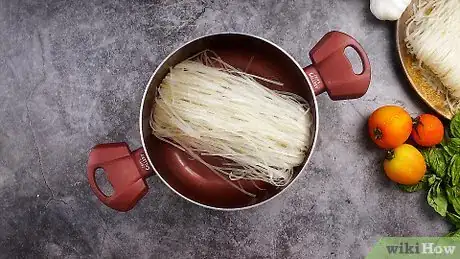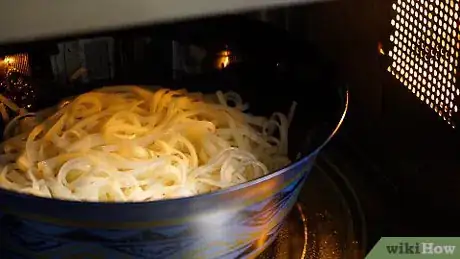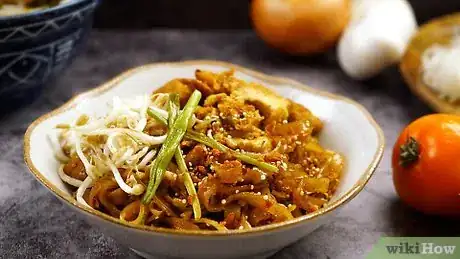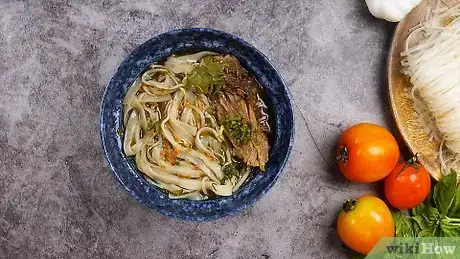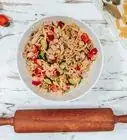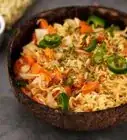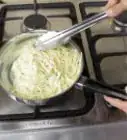This article was co-authored by wikiHow Staff. Our trained team of editors and researchers validate articles for accuracy and comprehensiveness. wikiHow's Content Management Team carefully monitors the work from our editorial staff to ensure that each article is backed by trusted research and meets our high quality standards.
The wikiHow Culinary Team also followed the article's instructions and verified that they work.
This article has been viewed 597,530 times.
Learn more...
Rice noodles are a type of semi-transparent pasta made from rice flour and water. Most are very long and thin, but you can also find flat rice noodles, as well. These noodles cook notably fast and can actually turn to mush if cooked for too long, so it's important to know how to cook them properly.
Ingredients
Makes 4 to 6 servings
- 8 oz (225 g) rice noodles
- Water
- Sesame oil (optional)
Steps
For Stir-Fry Dishes or Soups
-
1If you plan on using the noodles in "pad Thai" or another stir-fry dish, use the lukewarm water. This method will partially cook the noodles so that they are somewhat soft but still hard on the inside.
- This method also works well if you are adding the rice noodles to soup, but you can add rice noodles to soup without soaking or cooking them first.
-
2Place the noodles in a large bowl or pot. Rice noodles are very brittle, so you need to be especially careful while handling them in their uncooked state. Otherwise, you will likely break more than a few.
- Note that fresh rice noodles are soft, but most rice noodles are sold in their hard, brittle form. Fresh rice noodles do not need to be cooked or soaked in water. Instead, they are added directly to the dishes they are served in or steamed.[1]
Advertisement -
3Cover the noodles with lukewarm water.[2] The water should be warm to the touch, but not yet steaming. Allow the noodles to soak for 7 to 10 minutes or until they just start separating.
-
4Prepare the noodles for the next step. Since these noodles are only partially cooked, you will either need to transfer them to another dish immediately or store them in a way that prevents them from sticking together or drying out.
- Drain the noodles. The easiest way to do so is to pass them through a colander.
- Rinse the noodles under cold water to stop the cooking process.[3] Drain once more.
- Add the noodles into the stir-fry or soup if the dish is near the end of its cooking process.
- If you are not ready to add the noodles to the dish yet, toss them with a small amount of sesame oil to prevent them from drying out or clumping together temporarily.[4] Store in a sealed container at room temperature to further slow the drying process.
For Cold Noodle Dishes
-
1Boiling water can be used to partially or fully cook the noodles, and is the only way to fully cook the noodles. Use this method if you do not plan on cooking the noodles further as part of another dish.
- The boiling method works especially well if you plan on using the rice noodles in cool noodle dishes, including salads and bean dishes. Boiling the noodles is also recommended for flat rice noodles used as wrappers.
-
2Place the noodles in a pot or heat-resistant bowl. Dry rice noodles are very brittle, so they must be handled carefully if you do not want to break them into tiny pieces.
- Fresh rice noodles are not brittle, but they are not cooked with boiling water. Instead, they are usually steamed or added to recipes without being soaked first.
-
3Pour boiling water over the noodles.[5] Unlike wheat noodles, rice noodles are not boiled in water over direct heat. Instead, they must be covered with boiling water and allowed to cook off the stove.
- To fully cook the noodles, allow them to soak for 7 to 10 minutes, stirring them gently every 1 to 2 minutes to help loosen them. The noodles are done when they are completely limp. Thin, thread-like noodles may cook in less than 7 minutes, while flat rice noodles may take more than 10 minutes if they are thick.
- Remove the noodles sooner if you plan on cooking them in another dish. The noodles should be pulled out once they just begin to separate if you plan on cooking them further in other hot dishes. This will only take a few minutes.
- To create a chewier noodle, pre-soak the noodles in lukewarm water before cooking them in boiling water. Soak the noodles in lukewarm water until they are just barely pliable. Drain, then finish cooking in boiling water for an additional 2 minutes or until the center is chewy but not hard.
-
4Toss the noodles with sesame oil. Tossing the rice noodles with sesame oil will prevent them from clumping together or drying out, which is ideal if you plan on serving them on their own or in cold dishes.[6]
- Skip this step if you are immediately adding the rice noodles to another cooked dish.
Correcting Over-soaked Noodles
-
1Let the noodles sit out for a while. If the noodles are over-soaked but not mushy or falling apart, you can dry them out somewhat by allowing them to air dry. They will not return to their fully dry state, but they will become partially dry.
- Drain the rice noodles. The easiest way to do so is by pouring the contents of the bowls through a colander.
- Lay the moist noodles out flat. Place them in a single layer on a large plate or platter. Allow them to dry for at least 30 minutes in a draft-free area.
-
2Put the rice noodles in the microwave for a few seconds. Place slightly over-soaked noodles in a microwave-safe dish and microwave for 5 to 10 seconds.
- Drain the noodles by pouring them through a colander.
- Place the noodles in a microwave-safe dish and microwave on high for 5 to 10 seconds. The resulting noodles will by chewy.
Serving Suggestions
-
1Serve in stir-fries. Thin, cooked rice noodles present a good alternative to standard rice for Asian-inspired stir-fries.
- Rice noodles are a key feature of Pad Thai, a specific type of stir-fry commonly consisting of eggs, fish sauce, red chili pepper, tamarind juice, and other protein and vegetable ingredients.
- If adding the rice noodles to the stir-fry as it cooks, do so during the last few minutes and only partially cook the noodles beforehand.
- If pouring the stir-fry ingredients over rice noodles after you finish cooking everything, use fully cooked noodles.
- If using fresh noodles instead of dried, add them directly to the stir-fry during the last few minutes without previously soaking or cooking them.
-
2Add to soup. Rice noodles work well in Asian-inspired soups and soups belonging to other cuisine types, as well.
- The best way to add rice noodles to soup is to add uncooked noodles to the broth during the last few minutes of cooking. Monitor closely to make sure that the noodles are not becoming overcooked.
- You could also add partially cooked noodles to the broth, but you should add them after the soup has already been removed from the heat and immediately prior to serving. The hot broth will be enough to finish cooking the noodles even without being over direct heat.
-
3Use the noodles in cold dishes. Use fully-cooked rice noodles in dishes that don't require any additional cooking.
- Asian-inspired vegetable salads, cold bean dishes, and cold soups are good examples.
Community Q&A
-
QuestionHow long do I need to cook rice noodles when they're being used as a substitute for spaghetti?
 Community AnswerYou can boil the noodles for 7-10 minutes to fully cook them.
Community AnswerYou can boil the noodles for 7-10 minutes to fully cook them. -
QuestionIf I bought flat rice noodles that came in plastic packages, do I just steam them, and how do I do that
 Community AnswerBoil them in water for a few minutes. Depending on thickness, flat usually takes less time, with or without salt. Taste to see if it is undercooked. When done, wash with cold water or pour into a strainer.
Community AnswerBoil them in water for a few minutes. Depending on thickness, flat usually takes less time, with or without salt. Taste to see if it is undercooked. When done, wash with cold water or pour into a strainer. -
QuestionCan I serve the noodles with ratatouille?
 Community AnswerThere is no reason why you couldn't do that, as the rice noodles are plain in flavor, and will match well with many other flavors. It is not a traditional combination but home cooks are free to experiment and find their own preferred dishes!
Community AnswerThere is no reason why you couldn't do that, as the rice noodles are plain in flavor, and will match well with many other flavors. It is not a traditional combination but home cooks are free to experiment and find their own preferred dishes!
Things You'll Need
- Large heat-resistant bowl
- Kettle (for boiling water)
- Colander
- Fork or tongs
References
- ↑ http://www.foodsubs.com/NoodlesRice.html
- ↑ http://www.thaitable.com/thai/ingredient/thai-rice-noodles
- ↑ https://www.thekitchn.com/cooking-basics-how-to-cook-rice-noodles-129104
- ↑ https://www.thekitchn.com/cooking-basics-how-to-cook-rice-noodles-129104
- ↑ https://www.thekitchn.com/cooking-basics-how-to-cook-rice-noodles-129104
- ↑ https://www.bonappetit.com/story/how-to-cook-rice-noodles
About This Article
The best way to cook rice noodles depends on what dish you’re using them for. If you plan on cooking the noodles again in pad Thai or another stir-fry recipe, you only need to partially cook them in lukewarm water first. Place the noodles in a large pot and cover them with lukewarm water. Then, let them soak for 7-10 minutes or until they just begin to separate. Drain the noodles in a colander and rinse them with cold water to stop the cooking process. Finally, add them to your other dish when it’s nearly finished cooking. Alternatively, if you only plan on cooking the noodles once, you should use boiling water. Place the noodles in a pot, and bring water in a separate pot to a boil. Pour the boiling water over the noodles, then let them soak for 7-10 minutes, stirring them occasionally. Finally, drain the noodles and serve. To learn more, including how to keep your noodles from clumping or drying out, read on.
